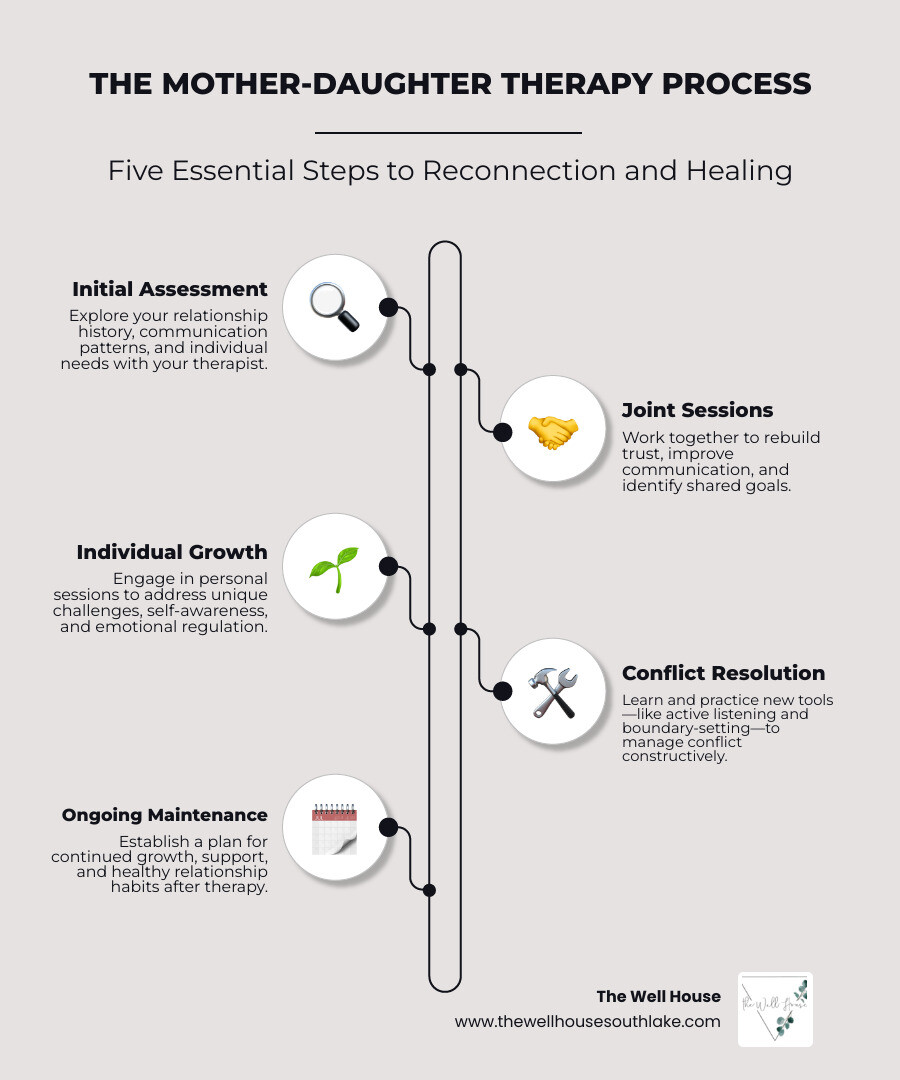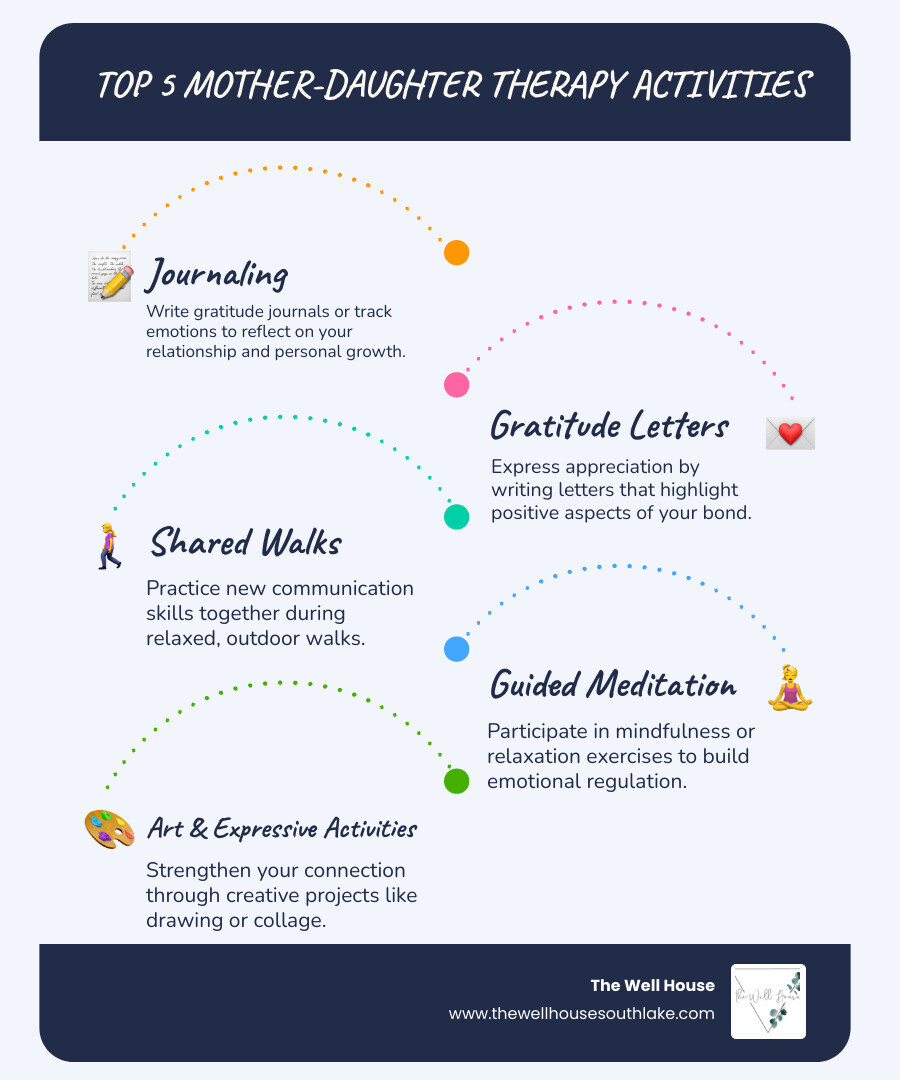Healing Together: Your Guide to Mother-Daughter Therapy
Why Mother-Daughter Relationships Are Worth Fighting For
Finding the right therapist for mother and daughter can transform one of life’s most complex relationships into a source of strength and joy. Here’s what you need to know:
What is Mother-Daughter Therapy?
- Joint sessions focusing on communication and attachment
- Individual sessions to address personal growth
- Evidence-based approaches like the Mother-Daughter Attachment Model™
- Tools to break unhealthy generational patterns
Signs You Need Help:
- Frequent arguments or walking on eggshells
- Emotional distance or unresolved hurt
- Anxiety spikes during interactions
- Feeling misunderstood or unheard
Common Benefits:
- Improved communication and trust
- Stronger emotional connection
- Healthy boundary setting
- Breaking cycles of conflict
The mother-daughter relationship is profoundly important for emotional wellbeing and development. Research shows that mothers and daughters need each other throughout life, yet this bond can become strained by generational patterns, changing life stages, and communication breakdowns.
The reality is sobering: estrangement between mothers and daughters has increased dramatically in recent years. What was once rare is now common, with many adult daughters in their twenties and thirties cutting contact with their mothers. But there’s hope.
Mother-daughter therapy offers a structured path to healing. Whether you’re navigating teenage years, adult relationship challenges, or trying to repair years of hurt, professional support can help you “come back home to each other.”
As Jennifer Kruse, Licensed Professional Counselor Supervisor in the Dallas-Fort Worth area, I’ve seen how powerful it can be when mothers and daughters commit to healing together – whether you’re seeking a therapist for mother and daughter support or working through complex family dynamics. My soul-mind-body approach helps families explore the deeper patterns that shape their relationships while building practical skills for lasting change.

Therapist for mother and daughter terms at a glance:
What Is Mother-Daughter Therapy?
Mother-daughter therapy is a specialized form of family counseling that focuses on the unique dynamics between mothers and daughters. Unlike traditional individual therapy, this approach recognizes that the mother-daughter relationship exists within a complex web of attachment patterns, generational influences, and cultural expectations.
At its core, mother-daughter therapy combines both joint sessions where mothers and daughters work together, and individual sessions that allow each person to explore their own experiences and emotions. This dual approach ensures that both parties feel heard while also addressing the relationship as a whole.
The therapy structure typically includes:
- Joint sessions where mothers and daughters practice new communication skills in real-time
- Individual sessions to process personal experiences and develop self-awareness
- Homework assignments that reinforce skills learned in therapy
- Family history exploration to understand generational patterns
The goals of mother-daughter therapy are multifaceted. We work to improve communication, establish healthy boundaries, resolve conflicts constructively, and foster emotional understanding. Most importantly, we aim to help mothers and daughters see each other as whole, complex individuals rather than just in their familial roles.
The Mother-Daughter Attachment Model™ Explained
The Mother-Daughter Attachment Model™ represents a breakthrough in understanding this unique relationship. Developed by specialists in mother-daughter dynamics, this model recognizes that the mother-daughter bond is fundamentally different from other family relationships due to shared gender experiences and societal expectations.
The model emphasizes that mothers are people first – not just caregivers. This seemingly simple concept challenges the cultural narrative that “good mothers must put children first,” which often leads to maternal depletion and identity loss. When mothers lose themselves in the role, it can create resentment, boundary issues, and emotional distance.
History mapping is a crucial component of this model. Through guided exercises, mothers and daughters explore their family’s generational patterns, identifying how beliefs about womanhood, motherhood, and relationships have been passed down. This process often reveals how patriarchal systems and cultural expectations have shaped their interactions.
The model also addresses the impact of what researchers call “multigenerational sexism” – the ways that societal limitations on women have been internalized and transmitted through family lines. By understanding these broader forces, mothers and daughters can begin to separate their personal relationship from these inherited burdens.
Scientific research on attachment and wellbeing supports the importance of secure attachment in mother-daughter relationships, showing that healthy bonds contribute to better emotional regulation, self-esteem, and relationship skills throughout life.
When Does a Mother-Daughter Relationship Need Help?
The increase in mother-daughter estrangement is alarming. Where estrangement was once rare and reserved for the most abusive relationships, it has become increasingly common. Many daughters in their twenties and thirties are cutting contact with their mothers, often leaving both parties confused and heartbroken.
Warning signs that a relationship could benefit from professional help include:
- Walking on eggshells – feeling like you must carefully monitor every word to avoid conflict
- Emotional distance – conversations remain surface-level, avoiding deeper topics
- Boundary violations – one or both parties consistently overstep personal limits
- Repetitive conflicts – the same arguments happen repeatedly without resolution
- Feeling unheard – expressing that “you just don’t understand” becomes a common refrain
These patterns often develop gradually. What starts as normal developmental changes – like a daughter’s need for independence during adolescence – can escalate into entrenched patterns of miscommunication and hurt feelings.
Common Challenges Addressed in Sessions
Mother-daughter therapy addresses a wide range of challenges that can strain this vital relationship. Understanding these common issues helps normalize the struggles many families face and provides hope that healing is possible.
Conflict triggers often center around fundamental differences in values, lifestyle choices, or life stage priorities. For example, a mother might struggle to accept her daughter’s career choices, parenting style, or relationship decisions. These conflicts become particularly intense when they touch on deeply held beliefs about what it means to be a “good woman” or “good mother.”
Adolescence changes present unique challenges as daughters naturally seek independence while mothers may struggle to let go. This developmental phase can create tension around autonomy, decision-making, and emotional support. Family therapy during the teen years can be particularly beneficial for addressing these evolving dynamics.
Perfectionism pressure affects many mother-daughter relationships, especially when mothers project their own unfulfilled dreams onto their daughters or when daughters feel they must live up to impossible standards. This dynamic can create competition rather than collaboration.
Role reversal occurs when daughters feel responsible for their mother’s emotional well-being, or when mothers rely on their daughters for support that should come from adult relationships. This pattern can create resentment and prevent healthy individuation.
Trauma legacy impacts many families, as unresolved trauma from one generation can affect relationship patterns in the next. This might include experiences of abuse, neglect, mental illness, or significant losses that haven’t been properly processed.
Signs You Need a Therapist for Mother and Daughter
Recognizing when professional help is needed can be challenging, especially when relationship difficulties have developed gradually over time. Here are key indicators that suggest a therapist for mother and daughter could be beneficial:
Frequent arguments that follow the same patterns without resolution indicate that you’re stuck in unhealthy communication cycles. If conversations consistently escalate to yelling, blame, or personal attacks, professional intervention can help break these patterns.
Silent tension can be just as damaging as open conflict. If you find yourselves avoiding difficult topics, walking on eggshells, or maintaining only surface-level conversations, this emotional distance needs attention.
Unresolved hurt from past conflicts or disappointments can poison current interactions. When old wounds keep reopening, it’s time to address them with professional support.
Anxiety spikes before or during interactions with each other suggest that the relationship has become a source of stress rather than support. This is particularly concerning when it affects daily functioning or other relationships.
Depression symptoms related to the relationship – such as feeling hopeless about ever having a good relationship, grieving the relationship you wish you had, or experiencing persistent sadness about family dynamics – warrant professional attention.
Breaking Unhealthy Generational Patterns
One of the most powerful aspects of mother-daughter therapy is its ability to break cycles that have persisted for generations. Many of the challenges in current relationships stem from patterns learned in previous generations.
The “selfless mother role” is one such pattern that affects many families. This cultural expectation teaches that good mothers sacrifice their own needs, dreams, and identity for their children. While some sacrifice is natural in parenting, extreme selflessness can lead to resentment, boundary issues, and daughters who either rebel against this model or feel guilty for not living up to it.
Inherited beliefs about womanhood, relationships, and family roles often operate unconsciously. Through therapy, mothers and daughters can examine these beliefs and choose which ones serve them and which ones need to be released.
History mapping exercises help families understand how trauma, cultural expectations, and family myths have shaped their interactions. This process often reveals that many conflicts aren’t really about the current situation but about deeper, unresolved family patterns.
Forgiveness work is crucial but must be approached carefully. True forgiveness comes from understanding, not from pressure to “get over it.” Therapy provides a safe space to process hurt feelings and work toward genuine healing.
How a Therapist for Mother and Daughter Improves Connection
A skilled therapist for mother and daughter uses various techniques to rebuild connection and improve communication. The therapeutic process focuses on creating new patterns of interaction while addressing the underlying issues that have created distance.
Empathy training helps mothers and daughters see situations from each other’s perspectives. This isn’t about agreeing with everything the other person says, but about understanding their emotional experience and validating their feelings.
Active listening skills are taught and practiced in sessions. Many conflicts escalate because people feel unheard. Learning to listen without immediately defending or offering solutions can transform conversations.
“I” statements replace blame and criticism with personal expression. Instead of “You always…” or “You never…,” family members learn to express their own feelings and needs without attacking the other person.
Conflict resolution techniques provide structured ways to address disagreements. This includes learning to take breaks when emotions run high, focusing on specific behaviors rather than character attacks, and finding win-win solutions.
Role reversal exercises help each person experience the other’s perspective. This might involve literally switching seats and arguing from the other person’s point of view, which often leads to important insights.
Mindfulness practices help regulate emotions during difficult conversations. Simple breathing exercises or grounding techniques can prevent conflicts from escalating.
Boundary setting exercises teach both mothers and daughters how to establish and maintain healthy limits while still showing love and care.
Key Approaches a Therapist for Mother and Daughter Uses
Effective mother-daughter therapy draws from multiple therapeutic approaches, custom to each family’s unique needs and circumstances.
Family systems therapy views the mother-daughter relationship within the context of the entire family system. This approach examines how family roles, rules, and patterns affect the relationship and how changes in one relationship impact others.
Cognitive Behavioral Therapy (CBT) helps identify and change negative thought patterns that contribute to relationship conflicts. For example, if a mother consistently interprets her daughter’s independence as rejection, CBT can help challenge and reframe these thoughts.
Emotionally Focused Therapy (EFT) focuses on the emotional bonds between mothers and daughters. This approach helps identify underlying emotions beneath surface conflicts and works to strengthen secure attachment.
Narrative therapy techniques help families rewrite their stories. Instead of being stuck in narratives of disappointment or conflict, families can create new stories that emphasize growth, resilience, and love.
Attachment-focused activities such as eye contact exercises, affirming statements, and shared mindfulness practices directly strengthen emotional bonds.
Somatic techniques address how relationship stress is held in the body. This might include breathing exercises, progressive muscle relaxation, or movement-based interventions.
Telehealth options make therapy more accessible, especially for families dealing with geographic distance or scheduling challenges. Online sessions can be just as effective as in-person meetings when conducted through secure platforms.
Scientific research on mindfulness in family therapy demonstrates that mindfulness practices can significantly improve family communication and emotional regulation.
Practical Activities & Homework
Therapy extends beyond the session room through practical activities and homework assignments that reinforce new skills and deepen understanding.
Journaling exercises help both mothers and daughters process their experiences and emotions. This might include gratitude journals, emotion tracking, or reflective writing about family history.
Gratitude letters involve writing (but not necessarily sending) letters expressing appreciation for positive aspects of the relationship. This exercise helps shift focus from problems to strengths.
Shared walks or other activities provide opportunities to practice new communication skills in a relaxed setting. Physical movement can also help reduce tension and facilitate conversation.
Guided meditation or mindfulness practices help develop emotional regulation skills that can be used during difficult conversations.

| Therapy Format | Best For | Benefits | Considerations |
|---|---|---|---|
| Individual Sessions | Processing personal experiences, developing self-awareness | Safe space for honest expression, personalized attention | May not address relationship dynamics directly |
| Joint Sessions | Practicing communication skills, resolving conflicts | Real-time feedback, immediate application of skills | Requires both parties to participate willingly |
| Group Therapy | Learning from others, reducing isolation | Peer support, normalized experiences | Less personalized attention, privacy concerns |
Finding the Right Therapist & Getting Started
Choosing the right therapist for mother and daughter is crucial for successful outcomes. Not all therapists are trained in family dynamics, and fewer still specialize in the unique aspects of mother-daughter relationships.
When searching for a therapist, look for these qualifications:
- Licensed mental health professional (LPC, LMFT, LCSW, or psychologist)
- Specialization in family therapy or specifically mother-daughter dynamics
- Training in attachment theory and family systems approaches
- Experience with your specific age group (teen daughters vs. adult daughters require different approaches)
- Cultural competency if cultural factors play a role in your family dynamics
Logistics matter too. Consider whether you prefer in-person sessions or are open to telehealth options. Some families find that online sessions reduce the pressure of being in the same physical space, while others prefer the intimacy of in-person meetings.
At The Well House, we understand that every mother-daughter relationship is unique. Our collaborative, holistic approach addresses mind, body, and spirit wellness, and we offer both in-person sessions in our Southlake, Westlake, Grapevine, Roanoke, and Trophy Club locations, as well as telehealth options throughout Texas.
More info about Parent Coaching Southlake provides additional resources for families seeking support.
Questions to Ask Before Hiring a Therapist for Mother and Daughter
Before committing to therapy, ask potential therapists these important questions:
“How many years of experience do you have with mother-daughter relationships?” Look for therapists with specific experience, not just general family therapy training.
“What is your approach to mother-daughter therapy?” The therapist should be able to explain their methodology clearly and how it addresses your specific concerns.
“How do you handle confidentiality when working with mothers and daughters?” Understand what information might be shared between individual and joint sessions.
“Can you share any success stories?” While respecting client confidentiality, experienced therapists should be able to describe general outcomes and improvements they’ve seen.
“Do you offer secure telehealth options?” If online sessions are important to you, ensure the therapist uses HIPAA-compliant platforms and has experience with remote therapy.
How Long Until We See Results?
The timeline for seeing results in mother-daughter therapy varies significantly based on several factors: the severity of relationship issues, willingness to participate, consistency of attendance, and individual personalities.
Three-month programs are common and often show significant results. Research indicates that many families begin seeing improvements within 8-10 sessions, with most completing their therapeutic goals within a few months rather than years.
Weekly sessions typically provide the best momentum for change. Meeting regularly allows for consistent practice of new skills and prevents old patterns from re-establishing between sessions.
Progress markers include:
- Decreased frequency and intensity of arguments
- Increased willingness to share feelings openly
- Better emotional regulation during conflicts
- More frequent positive interactions
- Improved ability to set and respect boundaries
Maintenance planning is crucial for long-term success. This might include monthly check-in sessions, continued use of communication tools learned in therapy, and having a plan for addressing future challenges.
Online support through apps, resources, or periodic virtual sessions can help maintain progress between formal therapy sessions.
Frequently Asked Questions about Mother-Daughter Therapy
Can therapy work if only one of us attends?
While joint participation is ideal, therapy can still be beneficial if only one person attends. Individual therapy can help you:
- Develop better communication skills
- Learn to set healthy boundaries
- Process your own emotions and reactions
- Change your part in negative patterns
- Prepare for future conversations with your mother or daughter
However, lasting relationship change typically requires both parties to participate at some level. Sometimes individual therapy helps prepare someone to eventually invite their mother or daughter to join sessions.
Are online sessions as effective as in-person meetings?
Research shows that online therapy can be just as effective as in-person sessions when conducted properly. Online mother-daughter therapy offers several advantages:
- Accessibility for families separated by distance
- Comfort of familiar surroundings
- Flexibility in scheduling
- Reduced pressure of being in the same physical space initially
However, some families prefer in-person sessions for the intimacy and full presence they provide. The best format depends on your family’s preferences and circumstances.
How do we maintain progress after therapy ends?
Maintaining progress requires ongoing commitment to the skills and insights gained in therapy:
- Regular check-ins with each other about how the relationship is going
- Continued use of communication tools learned in therapy
- Mindfulness practice to maintain emotional regulation
- Boundary maintenance even when it’s challenging
- Gratitude practice to focus on positive aspects of the relationship
- Professional support as needed for tune-ups or new challenges
Many families benefit from periodic “booster sessions” to address new challenges or reinforce skills.
Insurance & Payment Options at The Well House Southlake
At The Well House Southlake, we believe that quality mental health care should be both accessible and affordable. Whether you’re seeking therapy, couples counseling, or online sessions, our goal is to make it easy for you to access therapy that takes insurance and supports your unique needs.
We currently accept:
- Blue Cross Blue Shield (BCBS)
- Aetna
- UnitedHealthcare (UHC)
- Self-Pay and Out-of-Network Options
If you’re exploring counseling that takes insurance or need help verifying your coverage, our team will guide you through each step — from confirming your benefits to booking your first session. We’re committed to making your experience simple and stress-free, so you can focus on what matters most: your well-being.
Conclusion & Next Steps
The journey of healing a mother-daughter relationship is deeply personal and profoundly worthwhile. Whether you’re dealing with recent conflicts or years of accumulated hurt, professional support can help you find your way back to each other.
Seeking help is a sign of strength, not weakness. It shows that you value the relationship enough to invest in its healing and growth. The mother-daughter bond is too important to leave to chance – it deserves the same attention and care you would give to any other significant relationship in your life.
Your next steps might include:
- Reflecting on the patterns and challenges described in this guide
- Discussing the possibility of therapy with your mother or daughter
- Researching qualified therapists in your area
- Scheduling an initial consultation to explore your options
- Committing to the process, even when it feels difficult
At The Well House, we’re committed to supporting families through their healing journeys. Our holistic approach recognizes that true healing addresses not just symptoms but the whole person – mind, body, and spirit. Whether you’re in Southlake, Westlake, Grapevine, Roanoke, Trophy Club, or anywhere in Texas through our telehealth options, we’re here to help.
More info about therapy for moms in Southlake provides additional resources for mothers seeking support.
The mother-daughter relationship has the potential to be one of life’s greatest sources of strength, wisdom, and love. With the right support and commitment from both parties, healing is not just possible – it’s probable. Your relationship is worth fighting for, and you don’t have to fight alone.
Take that first step. Your future relationship – and your family’s legacy – depends on the courage you show today.












